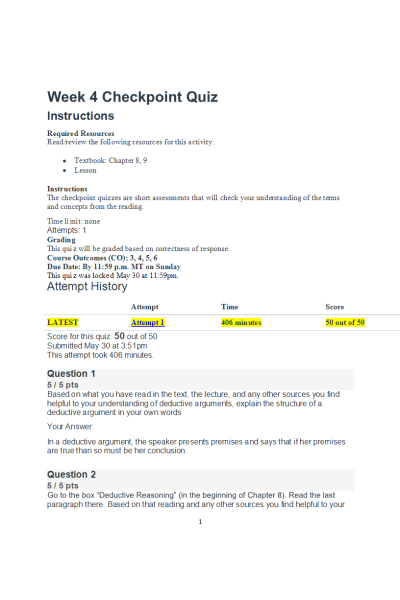PHIL 347 Week 4 Checkpoint Quiz (Score 50/50)
-
$25.00
| Institution | PHIL 347 Critical Reasoning |
| Contributor | Monesa |
- Question: Based on what you have read in the text, the lecture, and any other sources you find helpful to your understanding of deductive arguments, explain the structure of a deductive argument in your own words.
- Question: Go to the box “Deductive Reasoning” (in the beginning of Chapter 8). Read the last paragraph there. Based on that reading and any other sources you find helpful to your understanding, describe the part that “rules, operating conditions, core beliefs, values, policies, principles, procedures, and terminology” (p. 159) play in deductive arguments.
- Question: In the introduction to Chapter 8, the text sets forth a specific definition of the term “valid” as it applies to deductive arguments. What is that definition?
- Question: Use the following template to create a valid Denying the Consequent argument example:
If_________________ then _______________
It is not the case that ______________________
Therefore, it is not the case that ________________
- Question: the following template to create a valid Affirming the Antecedent argument example:
If_______________ then____________
________________________________
Therefore _______________________
- Question: Jack says: “I can enroll full time this semester, or I can buy a car. I think going to school full time is the better option for me, so I’ll have to put off buying car.” What name does the text give to this argument structure?
- Question: In addition to if/then and either/or, there are other terms that, when used correctly, can create valid argument templates. Using the three deductive statements below, create five (5) valid deductive arguments. To make your life easier, you can use the key words at the end of the statement to fill in the template.
- Question: Deductive reasoning implies the use of a given set of facts or data to deduce other facts from, by reasoning logically. It rearranges information that is already known into new statements or truths. Hence transitivity, reflexivity and identity refer to it and are necessary elements.
- Question: Using what you learned in Chapter 8 section Applying a Generalization, construct an argument proving that your Chamberlain major will place you in the category of healthcare worker.
- Question: A local newspaper serving a mid-sized U.S. city whose population is about 300,000 surveyed 40 retail businesses. Of the businesses surveyed, 70% said they were planning little or no hiring of extra workers during the coming Christmas season. The newspaper concluded that consumer spending would likely be down for Christmas this year, since retailers were not anticipating extra holiday business. Evaluate the newspaper’s generalization about consumer holiday spending using what you have learned in Chapter 9, including the four questions suggested by the text:
- Question: Go to Individual Exercises at the end of Chapter 9. Example 9 concludes that “the American people are opposed to the President’s health care reform legislation” (p. 190). Using the Four Tests for Evaluating Arguments found in Section 7.2 of the text, and keeping in mind all that you have learned from Chapters 7-9, evaluate the worthiness of Example 9, beginning with the Test of Logical Strength. Remember, if the argument fails a test, you do not need to go further. Give a detailed explanation in support of your evaluation. If the argument contains a fallacy, explain what you think the fallacy is.
- Question: What is a correlation? What is a statistically significant correlation?
- Question: Go to Individual Exercises at the end of Chapter 9. Go to Example 12. What test does this argument fail? What fallacy does the argument contain?
| Instituition / Term | |
| Term | Fall 2020 |
| Institution | PHIL 347 Critical Reasoning |
| Contributor | Monesa |

























